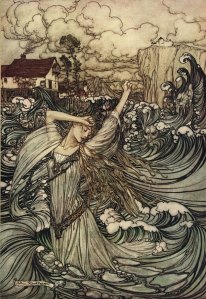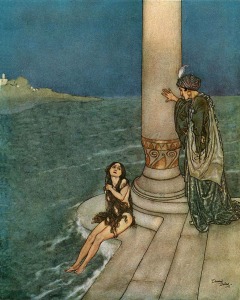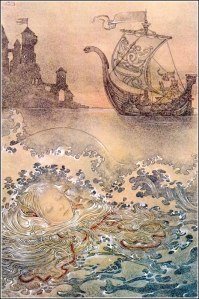So Terri Windling is a very obvious person to ask about mermaids, considering that she writes and edits and paints and draws wondrous, magical things and is an expert generally on folklore and myth, having, among many other things, co-edited The Journal of Mythic Arts for many many moons and published tons of books, fictional and non, about otherworldly things. There is a huge archive of information on the Journal of Mythic Arts site, and in fact I owe a large debt to said site for my own vast and deeply impressive mermaidly expertise. Really, it is like a great big treasure chest, like the kind a mermaid would find at the bottom of the sea.

Terri graciously answered my questions and also sent along some of her favorite pieces of mermaid art for your and my viewing pleasure. They’re by Arthur Rackham, Edmund Dulac, and Sulamith Wulfing. The same art that fills the apartment of Mr. Kaluta, which is what the Journal of Mythic Arts would be if it were a New York City apartment.
Here is our Q and A:
Why are so many of us enchanted by the mermaid, do you think? What is her allure?
In the folklore tradition, she is a symbol of freedom (she has all the wide sea for her home) and of sensuality. Water is her element, and all the wonders of the undersea world are her birthright. While we poor humans walk clumsily through the world, upright on our two spindly legs, she moves with speed and grace, flying through the waves with a flip of her beautiful tail.
What are some of your favorite mermaid myths?
I find myself most attracted to the seal women and otter women of Celtic and Scandinavian lore. Personally, I’d prefer to be able to transform completely from woman to otter or seal (and to know what it’s like to be fully animal) than to be a hybrid creature: part woman and part fish.
What do these myths do for us? Why are they so important?
They are part of the Animal Bride tradition, and these tales are among my very favorite in myth. I wrote an article about Animal Bride stories a while back, and I think this line from it captures what is, for me, the attraction of such tales:
“The Animal Bride and Bridegroom represent the wild within each one of us. They also represent the wild within our lovers and spouses, the part of them that we can never fully know. They represent the Others who live unfathomable lives right beside us — cat and mouse and coyote and owl; and the Others that live only in the dreams and nightmares of our imaginations. For thousands of years, their tales have emerged from the place where we draw the boundary lines between animals and human beings, the natural world and civilization, women and men, magic and illusion.”
What makes the mermaid – and mermaid stories – stand out (if they do) in folklore and fantasy art generally? That is, what is unique about the mermaid?
What I find interesting is that the modern conception of the mermaid has been so heavily colored by Hans Christian Andersen’s 19th century story The Little Mermaid – and then colored again, in the 20th century, by the Disney Studio’s complete re-shaping of the Andersen tale. The mermaid is pretty far removed, at this point, from the mermaids of the folklore tradition – which are generally seen as seductive, amoral, unfathomable, and dangerous.
What do you think the mermaid represented for Hans Christian Andersen?
Now that is an interesting and complicated question, because Andersen was an interesting and complicated man. Andersen’s Little Mermaid, of course, is (unlike the Disney film) a tragic story in which the mermaid trades her tail for legs “as sharp as knives,” all for a prince who is unable to love her back. He marries another, and the mermaid is reduced to foam upon the sea. What many Andersen scholars see in this story is a reflection of its author’s own tendency to fall passionately in love with women (publicly) and men (privately) who did not love him back. But I think it goes a little further than that. Andersen grew up working class and desperately poor…and even though, eventually, he achieved great fame and fortune, moving in the highest circles of 19th century Copenhagen, the upper class society of his day never let him forget his humble beginnings. He lived among them, but he was not one of them – a situation he found mortifying. So in addition to the theme of unrequited love, I also see class issues reflected in The Little Mermaid. The prince views his mermaid as a kind of lovely pet, but he goes on to marry a woman of his own kind. It’s a painful story, and in its pain I see Andersen’s feelings about being a perpetual outsider in the glittering social world that he’d struggled so hard to enter.
(I’ve written an article about Hans Christian Andersen too, if your readers are interested. And there are some very good books about him, listed at the end of the article.)
What about mermen – have you come across a number of interesting mermaid legends?
Oh, I love mermen, and selchie (seal) men! I think they’re kind of sexy. My very favorite comes from the old Scottish ballad “The Great Selchie of Sule Skerry,” which I first heard on an album by Judy Collins when I was a teenager. It haunts me to this day. I never did understand why the selchie’s lover would permit a gunner to kill him and her child…and therein lies a whole new tale….
The first annual mermaid convention will be held this year in Las Vegas, featuring pro mermaids Hannah Fraser and MeduSirena. “Mermaiding,” or swimming in mermaid tales, seems to be gaining popularity with a number of people. Johnny Depp held a press conference last year to announce the presence of mermaids in Pirates of the Caribbean 4. Are you aware of these trends – and/or surprised by the way the mermaid myth continues to move and inspire people?
I’m never surprised that myths and fairy tales move people even today. These are among the oldest stories of humankind; they’ve enchanted audiences young and old alike for thousands of years. They are powerful.
Have you yourself written/edited any mermaid tales, and/or been inspired by mermaids especially?
I haven’t written any mermaid or selchie or undine tales myself, but I’ve published them in various books and journals I’ve edited – such Melissa Lee Shaw’s “The Sea Hag” in Silver Birch, Blood Moon; Jane Gardam’s “Pangs of Love” in The Armless Maiden; and Laurie Mark’s “How the Sea Loved Margie” in The Journal of Mythic Arts. Ellen Datlow and I have recently co-edited an anthology called The Beastly Bride which has three relevant pieces in it: “Island Lake” by E. Katherine Tobler, “Map of Seventeen” by Christopher Barzak, and “The Selchie Speaks” by Delia Sherman.
There were also a couple of articles about mermaids published in my old web journal, The Journal of Mythic Arts: “A Million Little Mermaids” by Virginia Borges and “The Mermaid” by Heinz Insu Fenkl.
And some mermaid/seal-woman poems from the JoMA archives: “The Mermaid Sets the Record Straight” by Debra Cash; “Knives” by Jane Yolen; “Undine” by Jane Yolen, and “The Selkie Wife’s Daughter” by Jeannine Hall Gailey.
Do you have any advice for aspiring mermaids?
Please tell young aspiring mermaids that Disney had it all wrong. It’s never a good idea to give up a part of yourself (your fish tail or your voice) for the sake of love. Love is only true if you are valued for who you really are, fish tail and all.








Remember the 1948 Mr Peabody & the Mermaid?
http://en.wikipedia.org/wiki/Mr._Peabody_and_the_Mermaid
Great post,
thought you might like my machinima film
The Mermaid Queen
with Lisa Thiel’s lovely song
Bright Blessings ~
Black Fin a mermaid revealed herself to me last spring under the Sellwood Bridge in the early morning around 6 a.m on the Willametter river just south of the city of Portland. She was watching the fisherman along the river during the salmon run. She knew a man once who played the cello. She would come close to his houseboat on the river under the starlit summer sky and there she would sing to his music. They fell in love and a child was born. She was called back to the sea and when she returned the man child were gone. She spins a thread that glistens like a spider’s web under the moonlight. She called to me to be her friend.
It is actually a nice and useful piece of info.
I’m happy that you shared this helpful info with us. Please stay us informed like this.
Thanks for sharing.
info yang sangat menarik, sepertinya harus dicoba 🙂 , Affleck
人気ブランド一番コピー専門店グッチコピー服,人気商品があるの専門販売店ですグッチコピー服,コピーグッチ服,グッチ服コピー,グッチコピー tシャツ,Gucciコピー服を世界の一流なブランドコピーおすすめ。当社は日本で最高品質のコピーブランド代引き激安通販,スーパーコピー服代引き激安販売鶴橋ブランドコピー服新品通販優.
ブランドtシャツコピー http://www.vicpaynestudio.com